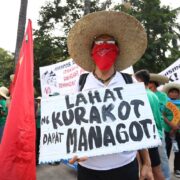P178-billion hike in PH debt interest payments hit
House Assistant Minority Leader Arlene Brosas on Tuesday lambasted the increase in the debt servicing allocation in next year’s proposed P6.352-trillion budget at the expense of programs that are actually beneficial to Filipinos.
The Gabriela women’s party list representative pointed out that interest payments on debt would rise by P178 billion to P848 billion in the 2025 budget from P670.4 billion in last year’s General Appropriations Act .
Brosas compared next year’s proposed budget to a “debt trap,” claiming that it was a “debt-driven disaster waiting to happen.”
She criticized the Marcos administration’s borrowings, saying “each Filipino family now owes P558,114,” and questioned how the loans were spent.
The lawmaker noted that the government has borrowed an average of P204.7 billion monthly over 23 months, more than double the rate of the previous Duterte administration.
“The Marcos regime is burying us deeper in debt at an unprecedented pace, while failing to deliver tangible benefits to the masses,” she said.
Brosas also expressed concern over the allocation of P1.327 trillion, or 20.9 percent of the proposed 2025 budget, for the Build Better More program and other infrastructure projects.
“How can we justify pouring billions into grandiose infrastructure when basic social services remain severely underfunded? The people are not benefiting from these loans, yet they are burdened with paying them back,” she stressed.
She called on her fellow lawmakers to scrutinize the proposed budget and realign funds to social services and programs that directly benefit the Filipino people.
“We cannot just pour the budget on debt servicing and infrastructure while Filipinos go hungry,” Brosas emphasized, urging budgetary priority for health, education and livelihood of Filipinos.
Manageable level
On Monday, Finance Secretary Ralph Recto said the Philippines’ outstanding debt that needed servicing remains high because loans made by the past administration to address the pandemic were still being repaid.
In a briefing on the proposed 2025 budget at the House of Representatives, Recto noted that the total debt in 2019 was only P7.7 trillion, but this nearly doubled to P13.4 trillion right after the pandemic as the Marcos administration took over.
“And because of all the geopolitical tensions, the cost of our borrowing has climbed postpandemic as central banks raised their interest rates to combat inflation. Therefore we are now refinancing the large borrowings contracted during the low-interest rate period in 2020 to 2022 with new debts at higher interest rates. This is why our interest payments next year are higher by around 11 percent,” he explained.
The Duterte administration borrowed a record P2.74 trillion in 2020 to fund the government’s response to the COVID-19 pandemic. This was more than double the P1.02 trillion the government borrowed in 2019.
Recto also clarified that while the country’s debt, which is expected to reach P16.1 trillion by the end of this year, looks big, the proper measurement was debt-to-GDP (gross domestic product) ratio as it is an indicator of a country’s ability to pay loans.
“We should not be alarmed by this, because the debt of a country should not be measured just by looking at its actual size. It’s better to compare it with the country’s economy because this is how we determine its ability to pay the loan, and one of the correct ways to measure is through the debt-to-GDP ratio,” Recto noted.
“If you would take a look at the Philippines’ debt-to-GDP ratio, we have started bringing it down from 60.9 (percent) in 2022, it’s now down to 60.1 in 2023, and we are determined to continue pushing it below 60 percent so we have enough buffer in case another crisis hits us,” he said.
Foreign lenders set a 60-percent threshold ratio as manageable for developing economies.
Record-high
The total government debt hit a new record high of P15.35 trillion at the end of May mainly due to the weakening of the local currency against the greenback, according to the Bureau of the Treasury (BTr).
BTr data showed that total state obligations increased by P330.39 billion in May, or by 2.2 percent from the previous month.
It attributed the higher debt to “the impact of local currency depreciation on the valuation of foreign-currency denominated debt.”
The peso weakened by 94 centavos to 58.52 against the dollar as of end-May from 57.58 in end-April.
Since the beginning of the year, total government liabilities have increased by P731.33 billion or 5 percent.
Domestic borrowings, which accounted for 68.04 percent of the total debt, rose by 4.2 percent or P424.91 billion in the five months to May to P10.44 trillion. Meanwhile, outstanding external debts stood at P4.9 trillion in May.
According to private economists, tax and fiscal reform measures would be needed to bring down the country’s debt-to-GDP ratio to less than the 60-percent international threshold. INQ

















